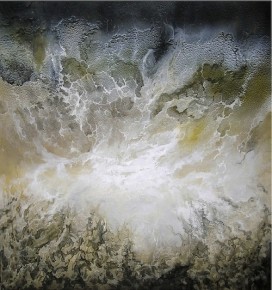
Why Intentions matter: Intentist Theory.
Intentism is an international arts movement. It is comprised of fine artists, poets, writers, musicians, actors and philosophers from all over the world. It is one of the fastest growing art movements in the UK at the present time.
The name Intentism is a response to the debate around authorial intent. Does it matter what the speaker/artist/author/ is intending what he or she says, paints or writes? Intentism maintains that the meaning of the work is the outworking of intention.
Our understanding of intention can often affect the way we view our experiences. Take a look at these two pairs of analogous events: After a violent altercation two men in Glasgow run over a 39 year old man, leaving him for dead; an OAP fails to see a pedestrian and knocks him down. A man incensed over unrequited love tracks down the object of his desires and shoots her dead; a woman from Cape Girardeau shoots and kills her attacker during an attempted rape. All tragic events, but should they be treated as equally terrible? In law, distinctions are made based on the perpetrator’s intentions.
It is the belief of the new international movement ‘Intentism’ that intentions matter in the arts too.
Intentism’s central belief may seem uncontroversial; however, this theory is commonly rejected based on arguments which call into question such thinking as: Am I aware of all my reasons for what I do? Might I not subconsciously disclose Freudian Slips? What about what I communicate? As a literate person won’t the clarity of my words or art speak for themselves, regardless of my intentions? Furthermore, do all readers approach the same work identically? Each time a couple says ‘This is our song’ doesn’t the ballad acquire a new meaning?
To many, these questions expose Intentionalism in the arts as an obvious fallacy.
Not so, say the Intentists. This debate has raged in different guises over the centuries for a reason. It hits to the heart at what sets us apart from other animals. How do we communicate? Can we communicate?
Firstly, language as a tool for communication, as Wittgenstein famously said, is essentially public. We share a common lexis. However, language is in a permanent state of flux. A brief listen to your teenage relative will inform you that every nut and bolt of language (noun, verb, adjective and adverb) is not immune to change in use. Pertaining to the visual arts, an interesting study is to look at how cultural associations with colours can be both varied and incompatible. For example, blue can represent immortality in China and mourning in Iran. So, it is far from certain that the work alone can always give us a fixed meaning (if that’s what we want.)
Secondly, with regard to each reader taking different things from what they read (‘What it means to me…’), far from being liberating, this view can cause further hermeneutic and semantic problems. What if I want to communicate something specific and clear? To an Intentist this is possible.
To an Intentist, meaning resides in the author’s intention, whether that intention is vague to invite multiple interpretations or specific. This is an important point since opponents of Intentism often argue that holding a work’s meaning accountable to the author/artist’s intentions limits the work. ‘Speech acts’ has helped classify verbal utterances and a similar approach can be applied to the arts. A speech act can be divided into three areas. Firstly, the locutionary act is the actual utterance and its ostensible meaning. Secondly, the illocutionary act which can be defined as the intended meaning and lastly, the perlocutionary act which is its actual effect on someone. This breakdown is helpful since it defines creative output as human acts with various purposes and can be applied to the arts as well. Therefore, if the writer/artist’s intention is to create words or images with very no defined, single intended meaning, the work would end at the locution stage. Certain poetry and abstract act may be a mixture of locution and illocution. On the other end of the scale a very prescriptive document like a bank manager’s letter would normally include a perlocutionary act.
Consequently, to solely rely on the text or the interests of the reader/viewer when a work has illocutionary properties can make misinterpretation more likely. Although the work is the most likely place to find the author’s intention, specifically because authors can successfully communicate in the work, communication is not always guaranteed. The celebrated Eros statue in Piccadilly was in fact designed and intended to depict the Greek God of requited love Anteros. (If on QI Alan Davies shouts out ‘Eros!’ to the question of what the statue means, listen out for the Klaxons.)
As to the multiple conflicting interpretations from readers, this diversity can bring richness to certain creative works. However, Intentists believe that it is possible to separate what your personal biases are from the meaning of the work. Literary critic E. D. Hirsch suggested that the author’s intention is the meaning of the work and what it ‘means to you’ is the work’s significance. (An inherent problem is how to distinguish the criteria by which we separate discovered intention from significance.) Intentists think this label is better suited describing works with more rigid intentions. However, where the art work is intended to touch people in numerous ways (certain music for example), the label appears a little weak.
Intentists further maintain that in rejecting authorship and intention some creative work has become anaemic and indifferent. In attempting to be all things to all people in certain cases the quality and efficacy has been diluted.
To sum up then: Why Intentism? For the very fact that in every human act, from car accident to gun crime, from written text to art installation; intentions simply do matter.
A second area that needs to be touched upon is authorship
One of the casualties of a rejection of intention has been to cast doubt on the relevance of the author. A seminal essay the ‘Death of the Author’ was penned by Roland Barthes in 1967. In this text Barthes asserted that ‘writing is the destruction of every point of origin’ and to ‘give a text an author is to impose a limit on the text.’ Barthes argument has parallels with other thinkers and movements that now dominate Anglo-American art schools with their shared conviction that works of art should be primarily understood by how minds receive them rather than by the human intentions that created them.
In this brief time I would like to look at two areas of theory that I believe are central to the debate: Firstly, The New Critics and texts, and secondly, Gadamar and the fine arts.
The New Critics Wimsatt and Beardsley’s essay ‘The Intentional Fallacy’ (1946) asserted two things that would influence Barthes. Texts have an independent status from the author and consequently the intention of the author is neither available nor desirable as a standard for judging a literary work’s success.
It should be noted that according to Wimsatt and Beardsley, even living authors intentions are never available. Moreover, if we were able to know an author’s explicit, comprehensive intentions, they would not be desirable. The meaning resides in the text alone.
However, if texts are independent from authors and the meaning does reside in the work alone then we shouldn’t refer to it as if it were connected to the author in some way; for example Turner’s work or Derrida’s work. Of course this is precisely how we do refer to them and interestingly so do Wimsatt, Beardsley and even Barthes. Furthermore, rejecting authorship would be to treat a landscape by Turner the same as we treat nature itself. Although we delight in both, we treat the artwork differently- why? Intentists would suggest one reason is that we are recognising a mind behind it. We see it as a gesture formed through creative thinking or intention.
Any creative work is primarily a human gesture. A painting of nature is different from nature, an intentionally carved Stoneage tool is different from a naturally sharp flint. The human intentional gesture imbues the object with meaning.
A further implication of these claims that was later developed by Barthes is that a text can semantically change over time. It is clear that over time people have used a word to mean different things. (eg. Wicked, gay etc.) It is the contention of the Intentists that when these words are brought together in a text, these words have a fixed meaning in space and time by the human gesture and that any later change is a change in significance, not meaning.
Secondly, Gadamer has been hugely influential with fine art interpretation. Gadamer reasoned that works develop an ‘effective history’ as different cultures and peoples load new meanings. Influenced by Heidegger, Gadamer also emphasized the continuing narrative and baggage of our own lives. Since we are from a different place and time from the author, we can only understand when the two narratives happily meet; which he called the fusion of horizons. (Gadamer was content with this predicament and believed this must take place for any genuine understanding.) However, this narrative argument was formed and developed as a discursive model applied to writing. It is therefore very effective when interpreting texts since they clearly are narratorial and linear. We generally start and finish at the same place, reading letters and words sequentially. We discover the world of and in front of the text incrementally in space and time as both the texts and ourselves develop. However, Gadamer,Barthes, Foucault and Derrida have all used this established literary theory to understand fine art. Intentism as an arts movement argues that this theory overreaches itself. The reason is that many arts such as painting, sculpture and photography are anarrative. There is no order of experience expectation in these art forms. Furthermore, there are no public rules that say an artist can’t ignore perspective or colour theory in his work that parallel the public rules of language or genre. Without these public rules we can either echo Derrida that ‘meaning is constantly deferred’ or we need to know authorial intentions.
In conclusion, since most anti-intentionalist theory distinguishes between speech and writing, can it really be the case that if I were speaking to you now I could communicate with you?– however imperfectly – but when I begin to write or paint I become suddenly dead to you? Can a reader no longer ‘hear me’ when I pick up a pen? Can a viewer genuinely only see their own reflections in every artwork; their own face in every portrait? Is it truly impossible even with careful exegesis to know what a work might have meant? (An Intentist would say there is the world of difference between knowing omnisciently (impossible) and knowing something of it (possible.) Are we all so hermetically sealed in this bubble that no artist can communicate with us through their art?
In contrast, Intentists believe ‘that works can convey the artist or author’s intended message to his or her intended audience.’ (Taken from the Intentist Manifesto. See www.intentism.com/manifesto.htm) A more thorough treatment of Intentist theory can be found in an essay at: https://www.culturewars.org.uk/index.php/site/article/intentism_the_resurrection_of_the_author )
The Search For Intentist Art
Although grounded in art theory, Intentism is primarily a practical arts movement. Since we argue that all art is intentionalist (the intention of the artist informs the viewer of the work’s meaning), we have often been asked how then does Intentist art differ from any other art?
Intentist artists work in numerous ways, but at present there appears to be three areas.
1. Palimpsestism and The Creative Trail.
Firstly, during the course of creating a work, an artist will have multiple intentions, including a meta-intention of the overall work and many micro-intentions as the art progresses. This journey has become known as the creative trail and is included in many intentist works as the artist intentionally leaves a visible trace of earlier marks normally edited out. This layering is on occasion referred to as Palimpsestism.
An example of palimpsestim is Vittorio Pelosi’s School of Postmodernism.
2. Irony
Secondly, since authorial irony can only be understood by comparing what is said (the work), and what is meant (author intent), it is a common subject for Intentist artists. An example here would be Luciano Pelosi’s Big Breakfast:
3. Anarrative Art
Finally, as was stated previously,much art theory regarding the Death of the Artist finds it origin in literary theory. It is a claim of the Intentists that in certain fundamental areas this cross over is not valid. From Heidegger to Gadamer to Ricoeur, a basis for the hermeneutical theory of a fusion of horizons is the relations between our narrative and the work’s narrative. This argument was intended for texts where the author has a linear order expectation for the text since the viewer will normally start at the beginning and read letters sequentially until the end. However, this approach is not valid for the static arts. Most paintings and sculptures are anarrative as viewers can approach the work in multiple orders. Therefore, this basis for ignoring the artist’s intentions is no longer valid. An example in this book of an Intentist artist creating work to demonstrate anarrative is Govinda Sah.
For more Intentist works accompanied by interviews with each artist see The Search For Intentist Art (https://www.intentism.com/apps/webstore/)
by Vittorio Pelosi





nicely written article
Having an intention and undertaking a work to convey that intention is a rational process for creating art, even if we actively choose to create intuitively. If we go with our intuitions we do not question what we do. But it is this very questioning of ‘what is’ that is essential to creativity. We doubt because we have an alternative something different that is better(?) In having an alternative to ‘what is’, we have created. This process does not happen intuitively it happens through rational processes. If we want to retain a creative aspect to art then we need to reconsider rational thinking strategies.
This is an important subject because it effects how we communicate on a very fundamental level. I think intentions are relevant because works are creative gestures. Yes, this is a very complex subject and needs more open debate.
I think that the capabilities and creativity of artists is shielded by far too much interpretation. Interpretation is incredibly valid an essential to viewing art, but I believe that Sonia understanding and valuing the intentions of an artist. Well said well written. Resurrect the author!
I am keen to explore this from a novel point of view
I think today’s individualistic and causalistic society bred the concept that each work can mean differently to each one of us. Although true, there needs to be recognition towards those who intended to convey a message or a state of mind because without their “intention” there would be no art!
I really like the work, i thinking about that, it´s true.
Resurrect the author!This is an important subject !!